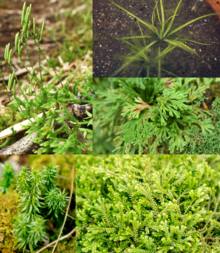Our website is made possible by displaying online advertisements to our visitors.
Please consider supporting us by disabling your ad blocker.
Lycophyte
| Lycophyte | |
|---|---|

| |
| Collage of modern lycophytes. Upper left: Lycopodium clavatum (Lycopodiales, Lycopodioideae) Lower left: Huperzia serrata (Lycopodiales, Huperzioideae) Top right: Isoetes japonica (Isoetales) Right centre: Selaginella tamariscina Lower right: Selaginella remotifolia Selaginellales | |
| Scientific classification | |
| Kingdom: | Plantae |
| Clade: | Tracheophytes |
| Clade: | Lycophytes |
| Classes | |
| |
The lycophytes, when broadly circumscribed, are a group of vascular plants that include the clubmosses. They are sometimes placed in a division Lycopodiophyta or Lycophyta or in a subdivision Lycopodiophytina. They are one of the oldest lineages of extant (living) vascular plants; the group contains extinct plants that have been dated from the Silurian (ca. 425 million years ago).[2][3] Lycophytes were some of the dominating plant species of the Carboniferous period, and included the tree-like Lepidodendrales, some of which grew over 40 metres (130 ft) in height, although extant lycophytes are relatively small plants.[4]
The scientific names and the informal English names used for this group of plants are ambiguous. For example, "Lycopodiophyta" and the shorter "Lycophyta" as well as the informal "lycophyte" may be used to include the extinct zosterophylls or to exclude them.
- ^ Kenrick, Paul; Crane, Peter R. (1997). The Origin and Early Diversification of Land Plants: A Cladistic Study. Washington, D. C.: Smithsonian Institution Press. pp. 339–340. ISBN 978-1-56098-730-7.
- ^ Rickards, R.B. (2000). "The age of the earliest club mosses: the Silurian Baragwanathia flora in Victoria, Australia". Geological Magazine. 137 (2): 207–209. Bibcode:2000GeoM..137..207R. doi:10.1017/s0016756800003800. S2CID 131287538.
- ^ McElwain, Jenny C.; Willis, K. G.; Willis, Kathy; McElwain, J. C. (2002). The evolution of plants. Oxford [Oxfordshire]: Oxford University Press. ISBN 978-0-19-850065-0.
- ^ Ranker, T. A.; Hauler, C. H. (2008). Biology and evolution of ferns and lycophytes. Cambridge: Cambridge University Press.
Previous Page Next Page


